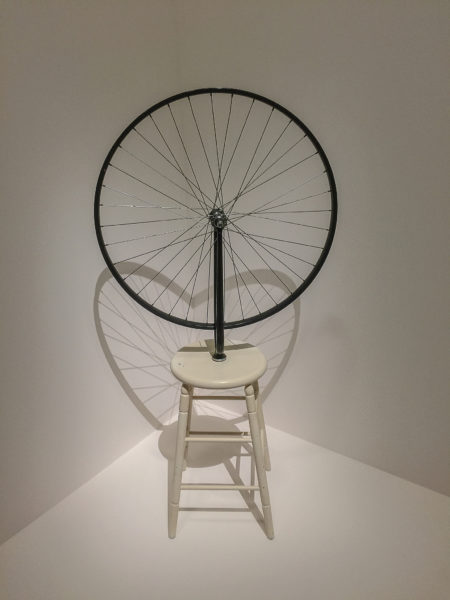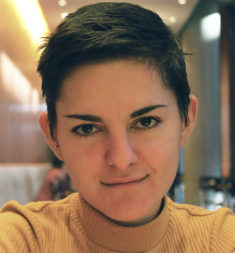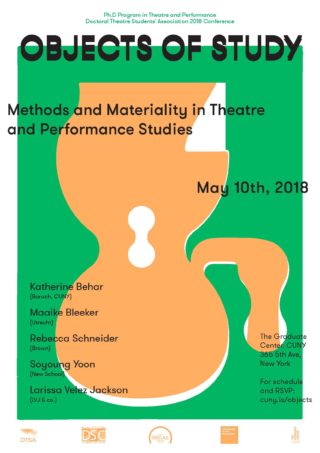On May 10, the Doctoral Theatre Students’ Association presents its 2018 conference, Objects of Study: Methods and Materiality in Theatre and Performance Studies, bringing together working groups of visiting scholars, graduate students, and independent artist-scholars to explore the multiple potential meanings of “object” within theatre and performance studies. In this two-part blog post, three of the conference organizers—Eylül Fidan Akıncı, Sarah Lucie, and Amir Farjoun, all students in the Ph.D. Program in Theatre and Performance—reflect on some of the questions about materiality and knowledge that arise in their field, and the particular challenges theatre and performance studies might offer to object-oriented thought.
Portions of the conference are open to the public; due to limited seating, please RSVP here before May 8th.
PART 1: “What Does the Materialist Turn do for Theatre and Performance?”
—Eylül Fidan Akıncı
“What is specific about objects and the new theories about them in performance, as opposed to or distinct from the way visual arts conceptualize them?” Kendra Sullivan, director of the Seminar on Public Engagement and Collaborative Research at the Center for the Humanities at the Graduate Center, CUNY asks us.
At a gut level, I feel there is a huge difference, even though these practices overlap historically in very interesting ways. They borrow each other’s techniques, ways of thinking, ways of presenting; yet, that convergence has evolved into different questions and concerns, too.
One guide to lead us into thinking the similarity/difference between performance and visual arts in relation to objects is Marcel Duchamp. Duchamp “liberated” objects, mundane objects, by drawing attention to their signifying capacities. With the works he is most famous for, the early “readymades” such as Fountain or Bicycle Wheel, he is in fact more semiotic than materialist; that is, more interested in the social circulation and disruption of meaning through objects than their intrinsic and concrete qualities and the experiences they allow in time and space. But in his overall theory and practice (which is pretty much the same thing for Duchamp), he is especially attuned to the sensuality of things (see Wedge of Chastity,). He realized (in both senses of the word) the performative invitation of the objects when lifted out of their submerged identities, and dragged them (again, in both senses of the word) out of their aesthetic and anesthetized passivity.
And then, Duchamp goes to America. In every historical account of postmodern dance, this is described as a big-bang event it has been repeatedly stated that he influenced the way Merce Cunningham thought about the principles of choreographic composition, which expanded the idea of body and movement beyond human and into the immaterial (see Burt, Franko, Laermans). Directly or indirectly, Duchamp gave impetus to the conceptual forays and working methods of a new generation of artists in the US, not only in visual arts but also in the fields of choreography and performance, most notably artists associated with Judson Dance Theatre, such as Yvonne Rainer, Trisha Brown, Steve Paxton, Lucinda Childs, Deborah Hay, and Simone Forti.. What is striking for me is that objects, sculptures, or architectural materiality “got performative” alongside bodies following upon this Duchampian influence: Not only were the methods of choreography transformed, but also, perhaps necessarily, the entities that choreography could grasp and graph-with.
The theatre and performance fields are in the process of integrating object-oriented and new materialist philosophies into its repertoire of thinking and analysis. We are now unraveling the significance of historical moments such as the one I roughly sketch above. Both visual arts and performance had these ruptures in the understanding of method and materiality, often at the same conjunction. Why separate them, then, or what separates them now? “Theatricality,” the notorious buzzword for the 1960s art criticism and even now, might be another clue to understand the fractures. Clement Greenberg and Michael Fried, two very influential figures in modern art history and criticism, dismiss Duchamp’s transformation of the connections between the object, display, meaning and audience as overly literal and banal provocations. Similarly, the works by minimalist sculptors such as Robert Morris and Donald Judd strike Fried as too literal and reliant on the audience’s bodily experience of the work in space and time, rather than manifesting meaning self-evidently, independently, and instantaneously. Fried calls this experiential necessity “theatricality,” in a derogatory sense. No wonder, since it was Forti’s choreographic experiments with the object, as another body in space, that inspired Morris to explore directions that he articulated in “Notes on Sculpture” (see Lepecki).
The philosopher Graham Harman, who coined and has been developing the field of Object-Oriented Ontology (OOO), pays close attention to Greenberg’s polemic view of Duchamp and Fried’s distaste for Morris, resituating these critics’ ideas within OOO’s approach to objects. Harman’s interest in the transformation of the status of the object in the visual arts is very understandable, given OOO’s aim to re-conceptualize the object, both philosophically and politically, in its autonomous reality. These art-historical debates similarly rehearse one of the central principles of OOO. Greenberg is insistent that the autonomy of the art object should surpass its dependence on commodity status, choices of display, reception and corporeal experience by the audience, and its critical potential for a certain strata or society. Likewise, OOO argues that an object is not limited to, dependent on, or defined by its qualities, signification, changing characteristics in time and space, or its relations with a human being or another object. OOO and the modernism that Duchamp and Morris were threatening connects on the point of autonomy: the object exists for itself and recedes even from itself, from its own qualities, and from the relations it forms.
“Theatricality” (as Fried uses it) or “mimesis” (as Harman uses it in a relational sense) seems to be anathema to that mode of existence, then. If so, is it paradoxical to try to think about the autonomy and power of objects from within theatre and performance?
PART 2: "We, Post-Benjaminians"
—Eylül Fidan Akıncı
The question of theatricality and mimesis has its own history of debate in relation to the post-modern and post-dramatic turns in performance (see Fischer-Lichte, Thies-Lehmann, Reinelt): for the sake of brevity, I will just say that the way Fried and Harman use these terms points to a very narrow exchange between audience, display, and representation, which is greatly complicated by the theories and practices in the larger domain of performance (see Sarah’s blog post). On the other hand, new materialist theories centering on network, performativity, and interaction (see Barad and Bennett, the most-cited theorists of our conference submissions) indeed seem to be more appealing to the theatre and performance field, which is not lost on Harman.
This alignment is understandable, since unlike the “autonomous” (literally, self-lawgiving) objects of modernist visual art, performance does not need to hide the human agent behind the work. In fact, both as the maker and the receiver, the human is central to performance (or at least performance field’s own modernist history revolved around the question of that centrality and, more recently, who and what is considered “human”). Equally important to this history has been the evolving awareness of the interrelation of all elements. Performance has refrained from thinking solely about human-centered categories such as characters, representations and narratives, and rather conceived of performance as a whole system that we call, maybe elusively, "dramaturgy." After all, due to its systems-thinking, the metaphor of theatre inspired a whole theory/methodology of materiality (try to guess it without looking at the references).
A small bracket is necessary here to be accurate: This theatrical history does not necessarily correspond to the choreographic history I sketch above, since a good part of postmodern dance in the US was indeed interested in separating the elements of a composition, or allowing them be just next to each other without necessary transactions or transformations. One can argue that this is akin to OOO’s take, or still a form of relational thinking, but different in intensity or kind, depending on which philosophical perspective one chooses to approach with (enter the question of study, more on this in Amir’s blog post).
OOO’s philosophical stance opposes such centrality of relations between humans and nonhumans in defining the object’s existence, essence, and capacity. For that reason, it is a bit harder to reconcile theatre and performance’s approach to objects with OOO’s vocal denouncement of humans and relations. Unlike the new materialist camp, OOO does not suppose that acting or performing is essential for the objects ontologically. OOO agrees that objects perform, but as long as performance is a relational act, it brings about another object (which is equally an object, but not the same object). So, for OOO, performance is a derivation that does not bring us closer to understanding the ontology of an object, but instead diverts us from its independent reality, its self-standing allure, its indecipherable invitation.
I want to shake up the two alignments that might emerge from these overviews: visual arts with OOO, and performing arts with networks and interactions. As long as there is display, be it a mental display of contemplation or a physical display of gallery or stage, we enter into a zone of “make-believe,” the make-believe of the singular self-manifestation of things. What Duchamp did to the modernist approach to art was to prank this make-believe. Denouncing “theatricality,” Fried was wrong for the reasons that he was right: the moment we lose (or cannot get into) that make-believe and pan out to see the display for itself, there is indeed no autonomy. That holds true for not only minimalist sculpture, but any object on display or in play.
Theatre and performance’s (slight) difference from visual arts in approaching objects, I think, is mainly the acknowledgement of this limit and the license to push further and experiment with it. If postmodern art (or dance) history was rewritten through the legacy of someone, for instance, like Carolee Schneemann, given the complexity and multifaceted theories and practices she invented and developed around the object, display, authoriality, body, this difference might have been rendered meaningless (see Amir’s post). Perhaps, then, our thinking would not have been so dependent on the dialectics of distance and proximity, of alienation and immersion, of autonomy and relation between the viewer and the viewed, subject and object, or the human and the nonhuman. Theatre and performance’s privilege is in pragmatically using and refusing these dialectics, without holding on to the pretense of singularity or self-erasure on behalf of objects or humans. The scary side of “theatricality,” I’d argue, lies precisely in that pretense, in the relegation of experience as derivative, in a belated pursuit of aura.
References:
- Barad, Karen. 2003. “Posthumanist Performativity: Toward an Understanding of How Matter Comes to Matter.” Signs: Journal of Women in Culture and Society 28 (3): 801–31. https://doi.org/10.1086/345321.
- Bennett, Jane. 2010. Vibrant Matter: A Political Ecology of Things. Durham: Duke University Press.
- Burt, Ramsay. 2006. Judson Dance Theater: Performative Traces. London: Routledge.
- Fischer-Lichte, Erika. 2008. The Transformative Power of Performance: A New Aesthetics. London: Routledge.
- Franko, Mark. 2000. “The Readymade as Movement: Cunningham, Duchamp, and Nam June Paik’s Two Merces.” RES: Anthropology and Aesthetics, no. 38: 211–19.
- Fried, Michael. 1997. Art and Objecthood: Essays and Reviews. Chicago: University of Chicago Press.
- Harman, Graham. 2011. The Quadruple Object. Winchester, U.K.: Zero Books.
- ———. 2014. “Art Without Relations.” ArtReview.Com. September 2014.https://artreview.com/features/september_2014_graham_harman_relations/.
- ———. 2014. “Greenberg, Duchamp, and the Next Avant-Garde.” In Speculations V: Aesthetics in the 21st Century., edited by Ridvan Askin, Paul John Ennis, Andreas Hägler, and Philipp Schweighauser, 251–74. Brooklyn, New York: Punctum Books.
- Laermans, Rudi. 2015. Moving Together: Theorizing and Making Contemporary Dance. Antennae Series 18. Amsterdam: Valiz.
- Latour, Bruno. 2005. Reassembling the Social: An Introduction to Actor-Network-Theory. Oxford: Oxford University Press.
- Lehmann, Hans-Thies. 2006. Postdramatic Theatre. New York: Routledge.
- Lepecki, André. 2016. Singularities: Dance in the Age of Performance. New York, NY: Routledge.
- Morris, Robert. 1993. Continuous Project Altered Daily: The Writings of Robert Morris. Cambridge, MA: The MIT Press.
- Reinelt, Janelle. 2002. "The Politics of Discourse: Performativity meets Theatricality." SubStance 31, no. 2: 201-215.


